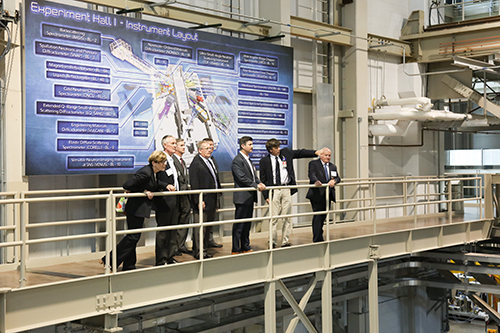Spallation Neutron Source (SNS)
SNS is a one-of-a-kind research facility that provides the most intense pulsed neutron beams in the world for scientific research and industrial development. SNS produces neutrons with an accelerator-based system that delivers short (microsecond) proton pulses to a target/moderator system, where neutrons are produced by a process called spallation. State-of-the-art experiment stations provide a variety of capabilities for researchers across a broad range of disciplines, such as physics, chemistry, materials science, and biology.
With its more intense, brighter source of neutrons and world-class instrumentation, SNS provides the neutron scattering community with unprecedented research opportunities. SNS allows for measurements of greater sensitivity, higher speed, higher resolution, and in more complex sample environments than have been possible at existing neutron facilities.
SNS is available to researchers from all over the world with varying degrees of experience. Submitted research proposals are reviewed by independent scientists from within the neutron scattering community, and the most promising ones are chosen.
High Flux Isotope Reactor (HFIR)
Operating at 85 MW, HFIR is the highest flux reactor-based source of neutrons for research in the United States, and it provides one of the highest steady-state neutron fluxes of any research reactor in the world. The thermal and cold neutrons produced by HFIR are used to study physics, chemistry, materials science, engineering, and biology. The intense neutron flux, constant power density, and constant-length fuel cycles are used by more than 500 researchers each year for neutron scattering research into the fundamental properties of condensed matter.
The neutron scattering research facilities at HFIR contain a world-class collection of instruments used for fundamental and applied research on the structure and dynamics of matter. HFIR is also used for medical, industrial, and research isotope production; research on severe neutron damage to materials; and neutron activation analysis to examine trace elements in the environment. Additionally, the building houses a gamma irradiation facility that uses spent fuel assemblies and is capable of providing high gamma doses for studies of the effects of radiation on materials.
Oak Ridge Leadership Computing Facility (OLCF)

Researchers from around the world use the Oak Ridge Leadership Computing Facility (OLCF) to solve problems so challenging they require the world’s most powerful computers. OLCF’s high-performance computing systems—supercomputers— coupled with the expertise of OLCF technical staff help solve challenges in diverse fields. These challenges include improving the safety and performance of nuclear power plants, designing new materials that can revolutionize industries, and modeling the origins of the universe. Supercomputers allow researchers to study subatomic particle interactions that only exist for fractions of a second and to simulate the volatile conditions inside a combustion or turbine engine, enabling a level of detailed analysis unavailable through traditional experimental means.
The OLCF is home to the nation’s fastest supercomputer, Summit, an IBM AC922 system that debuted in June 2018. Summit has a theoretical peak performance of 200 petaflops, which makes it possible for scientists to solve problems faster than ever before. Summit is at least eight times more powerful than its predecessor, Titan, which will remain active through FY 2019. Titan came online in November 2012 and has a theoretical peak performance of 27 petaflops.



